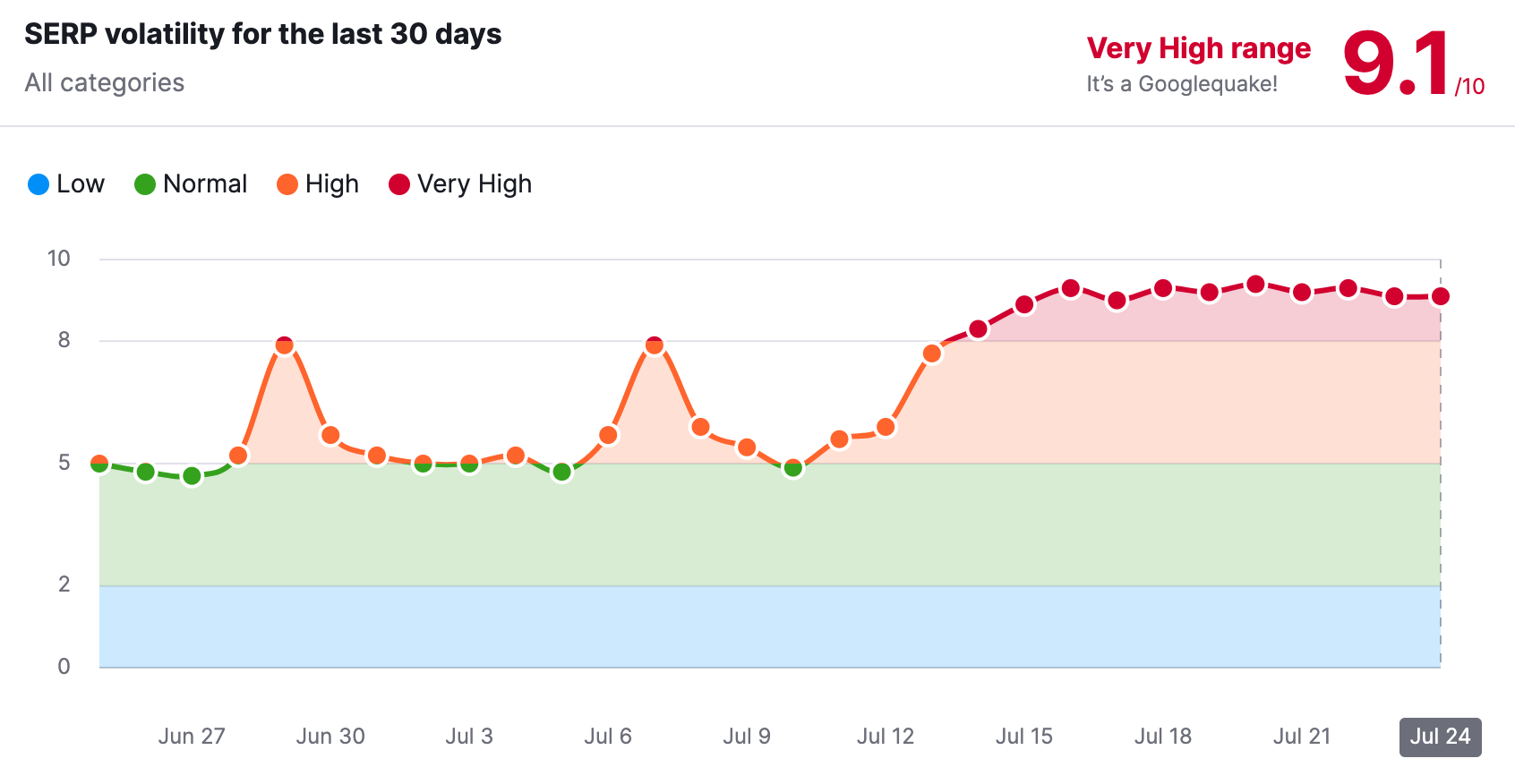Search engine optimization (SEO) is the practice of optimizing a website to improve its visibility and rankings in search engine results pages (SERPs). The goal is to have your web pages appear higher in search results for keywords and phrases relevant to your business, so you attract more organic traffic and customers. However, SERPs are not static. The rankings of web pages fluctuate and change over time, a phenomenon known as “SERP volatility”.
Understanding SERP volatility is crucial for monitoring and improving your SEO performance. This blog explains what SERP volatility is, what causes it, and why it matters for your SEO strategy.
What is SERP Volatility?
SERP volatility refers to changes and fluctuations in search engine rankings over a period of time. It indicates the lack of stability and predictability in SERP positions.
Some visible signs of SERP volatility include:
- Your rankings for important keywords shift up and down day to day or week to week.
- Competitor sites overtaking or falling behind your rankings unexpectedly.
- New entrants grabbing top positions and pushing you down.
- The same search query yields different results over time.
The extent of ranking fluctuations determines the degree of volatility. Minimal changes indicate a stable SERP, while frequent and dramatic shifts denote high volatility.
What Causes SERP Volatility?
There are several factors that contribute to SERP volatility:
- Search Algorithm Updates
Major search engines like Google and Bing periodically roll out algorithm updates to improve search quality. These updates aim to surface more relevant results but also impact rankings. Pages that get penalized may drop, while others may rise.
For instance, Google’s major updates like Panda, Penguin, Hummingbird, and BERT have triggered seismic ranking shifts in the past.
- Indexing Issues
Crawling and indexing issues can affect a page’s indexing status and cause rankings to drop. Problems like site outages, soft 404 errors, or technical SEO issues can prevent search engine bots from properly accessing and indexing pages.
- Competitive Dynamics
Increasing competition for rankings inevitably leads to churn in the SERPs. As new sites vie for top positions, they inevitably displace existing sites. Similarly, existing players amp up their SEO efforts, resulting in one-upmanship.
- Personalization
Search engines customize results based on user location, preferences, behavior, and profile. The same query yields different SERPs for different users. Personalized local listings and news also contribute to result variations.
- Testing by Search Engines
Search engines run countless tests to refine their systems, UI, layout, ad placements, etc. These regular experiments also cause fluctuations.
Why is SERP Volatility Important for SEO?
Understanding and monitoring SERP volatility is crucial for several reasons:
- Identify SEO Opportunities
Monitoring volatility helps spot keywords and pages that are gaining or losing rankings. You can dig deeper into rising competitors and optimize target pages to reclaim lost positions. New opportunities also emerge to improve rankings for uncontrolled keywords.
- Diagnose Issues Promptly
Sudden ranking drops are indicative of potential issues like indexing problems, penalties, or competitor actions. By regularly analyzing ranking volatility and fluctuations, you can rapidly detect and diagnose such problems. This allows you to investigate the root causes and address them before lasting damage is done.
- Gauge SEO Impact
Ranking fluctuations reflect the impact of your SEO efforts as well as external factors at play. Tracking volatility determines SEO ROI and helps forecast future performance.
- Adapt SEO Strategy
SEO is a moving target thanks to evolving algorithms, fresh entrants, and new challenges. Analyzing volatility signals the need to adapt and improve your strategy to boost resilience.
- Monitor Competitor SEO
SERP churn also reveals competitor SEO strategy at work. You can analyze their focus areas, new optimizations, and SEO initiatives by studying their volatility.
- Capitalize on SERP Shifts
Major algorithm updates often rearrange the SERP landscape. Being agile to capitalize on ranking volatility from updates is key to staying ahead.
- Improve Keyword Targeting
Targeting ultra-competitive keywords with low search volume is risky due to high volatility. Analyzing volatility helps pick more stable, high-value keywords.
- Enhance Ranking Strength
By identifying pages and keywords with high volatility, you can diagnose and resolve the issues weakening their rankings through technical SEO fixes, content optimization, earned links, etc.
- Set Realistic SEO Goals
SERP turbulence means rankings are not set in stone. Factoring in volatility gives you realistic goals and prevents overestimating potential SEO gains.
How to Track and Measure SERP Volatility?
Tracking and analyzing SERP volatility is crucial for staying ahead in SEO Delhi. Here are some ways to monitor it:
- Search engine tools like Google Search Console and Bing Webmaster Tools provide visibility into rankings and traffic changes. Comparing metrics week-over-week or month-over-month highlights trends.
- SEO tools like Moz, SEMrush, Ahrefs, and RankRanger offer historical ranking data. Their rank trackers and keyword analytics make volatility analysis easy.
- Ranking reports generated daily, weekly, or monthly reveal ranking gains/losses for target keywords. Using rank checkers like SERPwoo or RankActive compares reports over time to spot volatility.
- Site traffic analytics paired with search keyword reports reveal queries causing traffic fluctuations. This connects volatility to changes in keyword ranks and traffic.
- Alerts can automatically notify you of significant ranking changes or drops. Tools like SERP Shaker or SERPmetrics have alert capabilities.
Key ranking volatility metrics to track include:
- Ranking change: Rise or drop in rankings over time
- Average position change: Variation in average position for a keyword
- Ranking distribution: How many keywords move up or down
- Traffic change: Variation in organic traffic from keywords
- Impression share change: Increase or decrease in impressions
Minimizing SERP Volatility Impact
While you cannot totally eliminate SERP volatility, you can mitigate its impact by:
- Monitoring regularly to stay on top of changes
- Improving page quality and authority to sustain rankings
- Diversifying rankings across more keywords
- Targeting less competitive long-tail keywords
- Building links gradually and steadily to reinforce rankings
- Staying up-to-date with search algorithm changes




